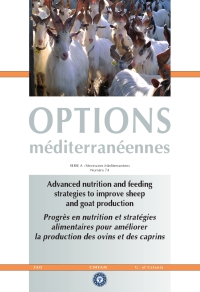| Article précédent | p. 263-267 | Article suivant |
In vitro ruminal fermentation of low-quality forages as influenced by the treatment with exogenous fibrolytic enzymes
The effects of three fibrolytic enzymes on the in vitro ruminal fermentation of five low-quality forages (three cereal straws (barley, wheat and rice), corn stover and grass hay) were investigated using batch cultures of mixed ruminal microorganisms. Four different treatments were investigated: no additive (control; CON), cellulase from Aspergillus niger (CEL; Fluka Chemie GmbH), xylanase from ruminal microorganisms (XYL; Megazyme International Ireland Ltd), and a 1:1 mixture cellulase:xylanase (MIX). Enzymes (20 IU/g forage dry matter (DM)) were applied directly onto the forages 24 h before incubation with buffered ruminal fluid at 39ºC for 24 h. The treatment with CEL increased (P<0.05) gas production after 24 h of incubation for wheat straw, barley straw and grass hay, whereas the treatment with MIX and XYL did not affect (P>0.05) gas production for any forage. For all substrates, neutral-detergent fibre digestibility (NDFD) and NH3-N concentration were not affected (P>0.05) by the addition of enzymes. The treatment of forages with CEL increased the production of propionate for grass hay, corn stover and barley straw, and increased (P<0.05) total VFA production for wheat straw and corn stover. No effects (P>0.05) of MIX and XYL treatments on VFA production were observed for any substrate. The results indicate that the pre-treatment of low-quality forages with fibrolytic enzymes under the conditions of the present experiment contributed little, if any, to ruminal fibrolytic activity.
Les effets de trois enzymes fibrolytiques exogènes sur la fermentation de cinq fourrages pauvres on été étudiés en utilisant une technique in vitro de type batch. On a utilisé 4 traitements : témoin (control, CON), cellulase d'Aspergillus niger (CEL; Fluka Chemie GmbH), xylanase de microorganismes ruminaux (XYL; Megazyme International Ireland Ltd), et un mélange 1:1 cellulase:xylanase (MIX). Les enzymes (20 UI/g MS fourrage) on été appliquées directement sur les fourrages 24 h avant leur incubation avec du contenu ruminal mélangé avec une solution tampon à 39ºC pendant 24 h. Le traitement avec CEL a augmenté (P<0,05) la production de gaz, pour la paille de blé, la paille d'orge et le foin de graminées, tandis que les traitements MIX et XYL n'ont pas modifié (P>0,05) la production de gaz des fourrages. Pour tous les substrats, l'addition d'enzymes n'a pas affecté la DFND ni l'azote ammoniacal. Le traitement des fourrages avec CEL a augmenté la production de propionate pour le foin de graminées, les cannes de maïs et la paille d'orge, ainsi que la production totale d'AGV (P<0,05) pour la paille de blé et les cannes de maïs. Aucune différence significative (P>0,05) n'a été notée entre les traitements MIX et XYL et le témoin pour la production d'AGV. Ces résultats montrent que le prétraitement des fourrages pauvres avec les trois enzymes fibrolytiques dans ces conditions expérimentales a très peu contribué à l'activité fibrolytique ruminale.
- [ Afficher ]
- [ Télécharger ]
- [ Exporter la citation ]
Vous pouvez télécharger la citation au format :
- [ Imprimer ]
-
Mots-clés
CELLULOSE, ENZYME, EXPERIMENTATION IN VITRO, FERMENTATION DU RUMEN, FOIN, FOURRAGE GROSSIER, METHANE, PAILLECiter cet article
Giraldo L.A., Carro M.D., Ranilla M.J., Tejido M.L., Mohamed A.H. In vitro ruminal fermentation of low-quality forages as influenced by the treatment with exogenous fibrolytic enzymes. In : Priolo A. (ed.), Biondi L. (ed.), Ben Salem H. (ed.), Morand-Fehr P. (ed.). Advanced nutrition and feeding strategies to improve sheep and goat . Zaragoza : CIHEAM, 2007. p. 263-267. (Options Méditerranéennes : Série A. Séminaires Méditerranéens; n. 74). 11. Seminar of the FAO-CIHEAM Sub-Network on Sheep and Goat Nutrition, 2005/09/08-10, Catania (Italy). http://om.ciheam.org/om/pdf/a74/00800389.pdf



